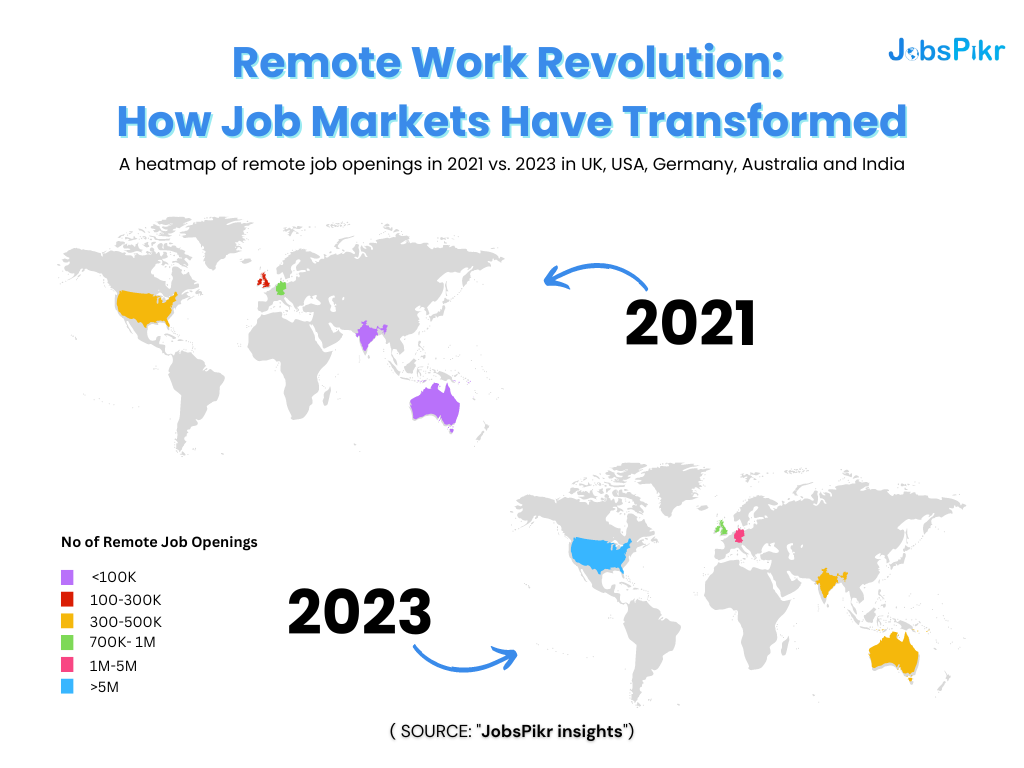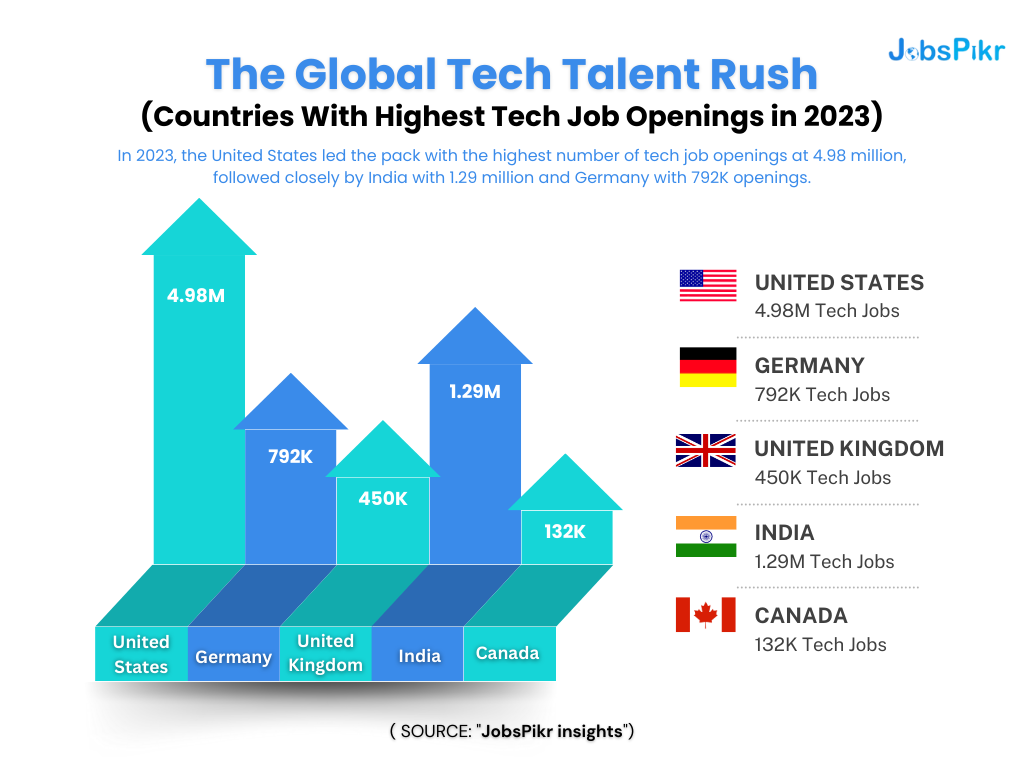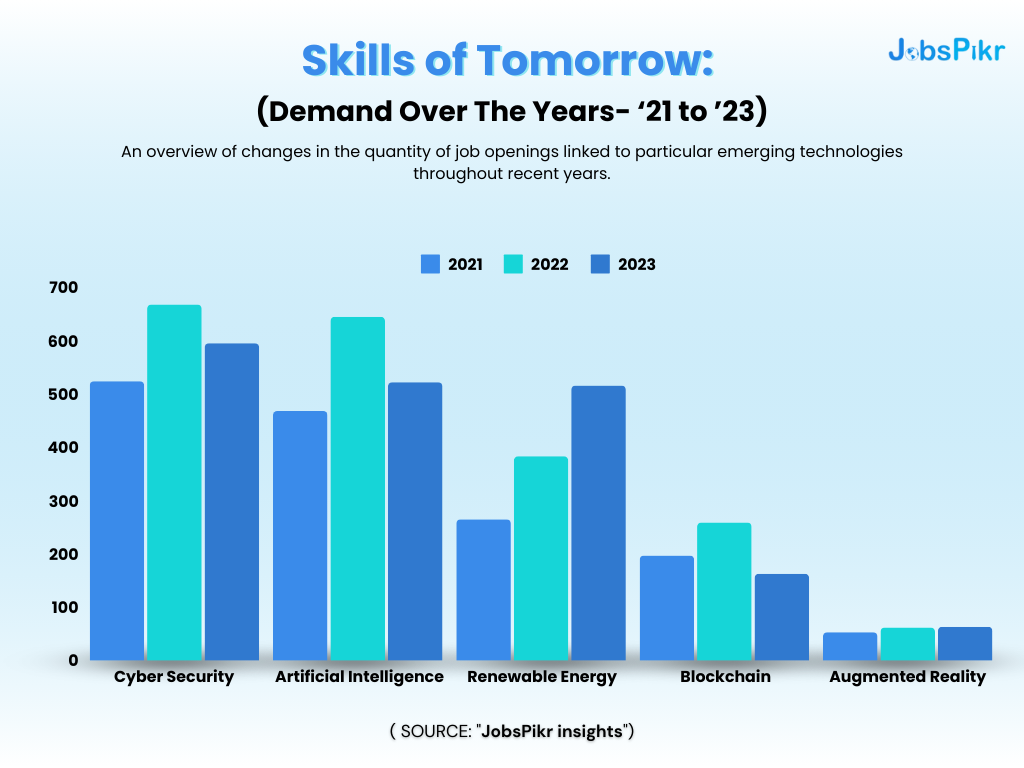The labor market in 2024 is shaped by dynamic trends influenced by technological advancements, evolving work preferences, and global economic shifts. By analyzing labor market trends in 2024, we can gain insights into how businesses and job seekers can navigate this changing landscape effectively.
This article explores the key trends shaping the job market and provides actionable insights for adapting to the current employment environment.
Labor Market Trends in 2024
1) Remote Work
Historical Growth and Current Trends
The remote work revolution has been one of the most significant shifts in the job market over the past few years. The adoption of remote work surged dramatically during the COVID-19 pandemic and has continued to transform how businesses operate and how employees work.
Data from JobsPikr illustrates the expansion of remote work across various countries:
- UK: Remote job postings grew from 173,000 in 2021 to 823,000 in 2023.
- Germany: Increased from 903,000 in 2021 to 1.3 million in 2023.
- USA: Expanded from 465,000 in 2021 to 7.27 million in 2023.
- Australia: Rose from 30,500 in 2021 to 366,000 in 2023.
- India: Climbed from 77,600 in 2021 to 336,000 in 2023.

Benefits of Remote Work
- Flexibility: Remote work provides employees with the flexibility to work from anywhere, leading to improved work-life balance.
- Cost Efficiency: Companies save on operational costs related to office space and utilities.
- Reduction in Commute Time: Eliminates the need for commuting, enhancing productivity and reducing stress.
- Access to a Wider Talent Pool: Employers can hire talent from diverse geographical locations, breaking the constraints of local talent shortages.
Implications for Job Seekers and Employers
Job seekers should focus on acquiring skills that facilitate remote work, such as proficiency in digital communication tools and self-management.
Employers, on the other hand, need to invest in remote work infrastructure and foster a culture that supports remote teams.
2) The Global Tech Talent Rush
Hiring Trends Across Continents
The demand for tech talent continues to soar globally, driven by the increasing reliance on digital solutions and emerging technologies. According to JobsPikr data:
- USA: Tech job postings increased from 2.47 million in 2021 to 4.98 million in 2023.
- UK: Grew from 492,000 in 2021 to 450,000 in 2023.
- Canada: Rose from 223,000 in 2021 to 132,000 in 2023.
- Germany: Significant jump from 182,000 in 2021 to 792,000 in 2023.
- India: Increased from 924,000 in 2021 to 1.29 million in 2023.

Key Factors Driving Demand
- Digital Transformation: Organizations are accelerating their digital transformation efforts, increasing the need for tech professionals.
- Emerging Technologies: Growth in AI, AR, blockchain, and cybersecurity fuels demand for skilled professionals in these domains.
- Global Talent Shortages: Many countries face a shortage of tech talent, leading to increased competition and higher salaries for qualified candidates.
Strategies for Success
Tech professionals should focus on continuous learning and staying updated with the latest technological advancements.
Employers can benefit from offering competitive compensation packages and creating appealing work environments to attract top talent.
3) Skills of Tomorrow: Emerging Technologies
Demand for Emerging Technology Skills
The rise of emerging technologies is reshaping the skillsets required in the labor market. JobsPikr data highlights the demand for skills in various emerging technology sectors:
- Artificial Intelligence (AI): Demand slightly declined from 645,000 in 2022 to 522,000 in 2023.
- Augmented Reality (AR): Remained relatively stable, with 62,200 postings in 2022 and 63,300 in 2023.
- Blockchain: Saw a reduction from 259,000 in 2022 to 163,000 in 2023.
- Cybersecurity: Slight decrease from 668,000 in 2022 to 595,000 in 2023.
- Renewable Energy: Increased significantly from 383,000 in 2022 to 516,000 in 2023.

Preparing for the Future
Job seekers should invest in acquiring skills related to emerging technologies through formal education, online courses, and hands-on experience.
Employers can foster innovation by creating opportunities for employees to work on cutting-edge projects and offering training programs.
Navigating the Dynamic Job Market: Actionable Insights
For Job Seekers
- Upskill Continuously: Focus on acquiring skills in high-demand areas, particularly in emerging technologies and remote work tools.
- Embrace Flexibility: Be open to remote and hybrid work opportunities to enhance employability.
- Network Actively: Engage in professional networks and online communities to stay informed about job openings and industry trends.
For Employers
- Leverage Remote Work: Invest in technology and policies that support remote work to attract and retain top talent.
- Focus on Retention: Provide competitive benefits, career development opportunities, and a positive work culture to reduce turnover.
- Innovate in Hiring: Utilize data-driven recruitment strategies to identify and attract candidates with the desired skillsets.
Conclusion
The labor market in 2024 is characterized by rapid changes and evolving trends. By analyzing labor market trends in 2024, businesses and job seekers can make informed decisions and adapt to the current landscape.
Embracing remote work, focusing on emerging technologies, and continuously upskilling are key strategies for navigating this dynamic job market successfully. Staying proactive and adaptable will be essential for thriving in the ever-changing world of work.



